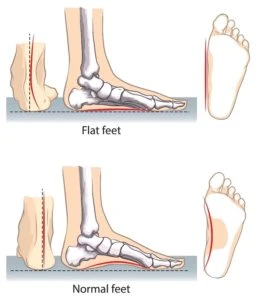Contents
You may have heard the expression: "Huh! I have flat feet". We think, alright you have fleet and move on. The truth and the matter is, flat feet does actually exist. In fact it is a very common condition amongst the population. Having flat feet is a condition affecting the foot structure. It all starts when you are a baby or when you are very young as a toddler. What happens is that prior to walk babies an toddlers will have the longitudinal arch that is not developed resulting in a flat foot.
Generally your feet are flexible and the arch will form up and appear. When a child starts to stand on their toes, this is the time the arch will begin to form. As you grow older, the arch continues its development. By the time you become an adult, your arches have developed in a normal fashion.
When talking about flat feet, we associate flat feet with pronation. A pronation is when the foot tend to roll in or lean inward. Your bones in your foot will going towards this interior of this straight imaginary line dissecting the length of the foot. So when you wear shoes, as a child, your shoes will wear in a way both are leaning towards the inside or towards each other. Continuing on like this, the foot can't go back to its normal position since the shoe is worn out in a way the pronation occurred over time.

When you flat feet, most of the time, you will not feel any pain. When the pain becomes evident, especially with children, then it is imperative to see a podiatrist and complete assessment.
Flat foot or flat feet is also known in the medical jargon as tibialis posterior tendonitis. When tibialis posterior tendonitis becomes a progressive and gradual pain in an adult, it is also referred as having an inflammation of the tendon at the tibialis posterior.
When this condition occurs, what is exactly happening is that the tibialis posterior tendon is inflamed, micro-torn, stretched, or torn. If you leave it untreated, further complications can develop. Complications such as chronic pain is a strong possibility.
The pain or inflammation originating from tibialis posterior tendonitis is very uncomfortable. Furthermore, it is worse if the posterior tendonitis is also affected by a progressive functional talotarsal joint subluxation. This long term is also referred as "collapsing feet", "over-pronating feet", "flat feet". This is at the point where an abnormal attachment of the affected tendon to the bones in the mid-foot has taken place.
The best method in treating flat feet is to build a specific design of an orthotic that the patient will have to wear simultaneously with an ankle and foot brace. One great example of these braces is the "Ritchie Brace".
After the collapsing feet are stabilized, the professionals will move on to the administration of a specific anti-pain and anti-inflammatory laser treatment program. This laser treatment program is 4 sessions normally. It is treated over a two-week period to promote faster and better tendon healing.
When suffering from collapsible feet or flat feet, the condition should not be delayed. It will bring further complications and you will suffer much more. In addition, it will reduce your capability of doing more physical activities. Don't wait until it is too late and take care of those feet, if you suffer from flat feet. It is important if you are having this condition that treating flat feet now will have long term positive effects.
 |
 |
 |
 |